GDC 2008 Coverage: Wrapping it Up
by Derek Wilson on February 25, 2008 10:30 PM EST- Posted in
- Trade Shows
The Future of Gaming (And Life as We Know It)
The major highlights of GDC 2008 for us were the keynote by Ray Kurzweil and the session on Fable 2 by Peter Molyneaux. Much of the unspoken context of the conference was on emergent gaming and on adaptive, evolving systems. These two people are certainly at the center of any such discussion, and the power and impact of their presentations was not lightly felt.

Kurzweil focused on the exponential growth of things. Not just on Moore's law, but on the exponential growth of everything leading up to it and everything that is to come after it. He puts the "the end is near" doomsayers to shame with his comprehensive analysis of the growth of technology and the audacity of the predictions he makes for computing. He talked about how billions of years ago it took millions of years to reach paradigm shifts in development, but today major changes and advancements happen on the order of hundreds and even tens of years.

Because the advancements of the present and future are built on the advancements of the past and today, things happen much faster due to the base of technology we already have. An example is that the first computers were developed with pen and paper over quite a while. Today, computers millions of times more advanced are developed in a fraction of the time using other computers, which will be used to help design the computers of the future, etc.
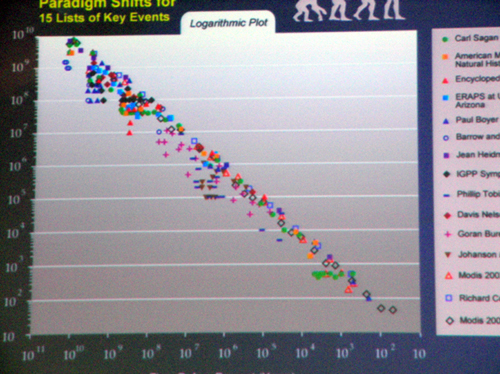
As for the end of Moore's law, Kurzweil predicts a paradigm shift. He points out that there is a sort of S curve in the advancement of technology where the slow down of one method of doing things puts pressure on the world to come up with a new way to do things. The way this translates to our current situation is that the Moore's law might start to slip and the pace of computing advancement may slow down as the physical limits on transistor size in silicon approach. But even if there is a short term slow down the over all trend will not stop and a new paradigm in computer design will take over and push exponential advancement forward.
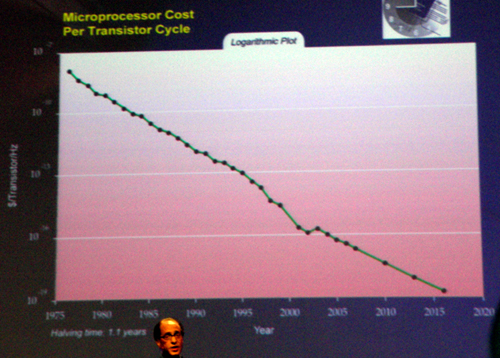
Kurzweil talks of future technology as if it is already fact, and it's quite astounding what he says we'll be able to do in only the couple decades. These are things like matching the compute capacity of the human brain by 2013, and being able to completely model the brain a decade or so later. He points out the fact that detractors of the human genome project were so focused on the fact that when half the time had gone by only a small percentage of the project was complete. Linear thinking limited their ability to understand exponential growth, and the problem is compounded by the fact that exponential curves appear linear initially.
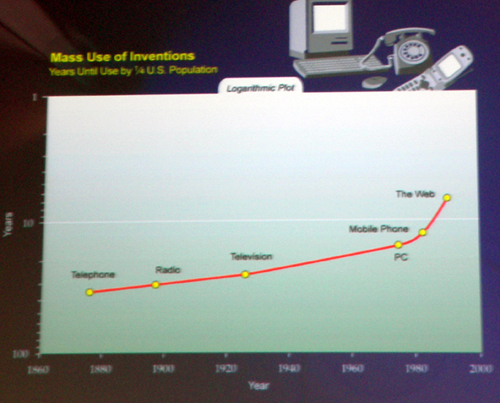
When we look at where we are and where we could go, the possibilities, not only of advancement in gaming but in the advancement of life as we know, it are staggering. Projections of the impact of fossil fuels on our economy and planet in terms of the next century are absurd in light of the fact that new technology will make energy cheaper and cleaner than currently possible. Replacing red blood cells with engineered alternatives could not only offer cures for diseases, but could also improve the functionality of the human body on a fundamental level (imagine being able to hold your breath for orders of magnitude longer than is currently possible).
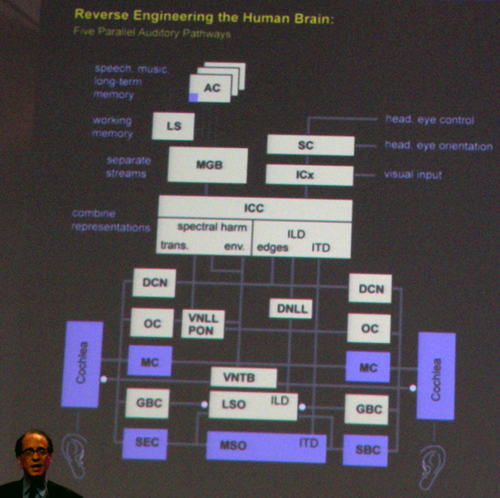
We have already been able to model the part of the brain that handles hearing. We are already genetically engineering plants, and now that we have the human genome, we will be able to update and improve the source code of our own bodies. Kurzweil points out that a genetic cure for type 1 diabetes (as well as obesity) is currently possible (at least in animal studies) and even bigger things will follow.
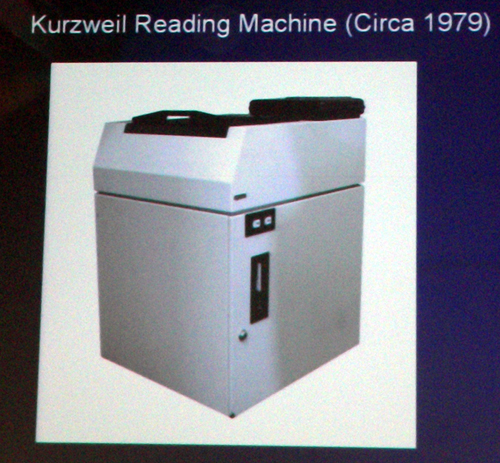
In a live demo, Kurzweil showed of some technology that really brought home his points. In the late 1970s, he invented the first machine that could convert written text to speech in order to aid the blind. He was able to predict, based on his exponential models of technological advancement, when he would be able to shrink this machine down to the size of a handheld device. This handheld device would need to be capable of much more than just scanning in a document and converting it to speech, as it would need to be held by a blind person and pointed at all sorts of strange angles at signs and books in order to be of any real use. Using a prediction of when this would be possible, Kurzweil was able to start designing the software and systems to perform this functionality in a way so as to time the finish of the project with the emergence of technology that would be able to support it.
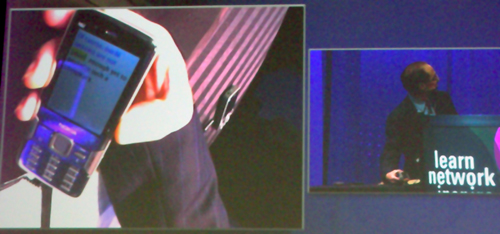
He showed off the technology in the form of a cell phone that was able to read text it was pointed at while the angle and distance from the device to the text was in flux. The demo was quite impressive, and the usefulness to the blind community is at once obvious and astounding.

Thinking non-linearly can be difficult, but I honestly hope that Kurzweil is accurate in his predictions. They sound pretty freaking cool to me. The bottom line: fully immersive virtual reality through nano scale technology and full simulations of human intelligence capable of passing the Turing test before 2030.










14 Comments
View All Comments
ebuyings0005 - Friday, September 4, 2009 - link
http://www.ebuyings.com">http://www.ebuyings.comthe website wholesale for many kinds of fashion shoes, like the nike,jordan,prama,****, also including the jeans,shirts,bags,hat and the decorations. All the products are free shipping, and the the price is competitive, and also can accept the paypal payment.,after the payment, can ship within short time.
free shipping
competitive price
any size available
accept the paypal
our price:
gstar coogi evisu true jeans $36;
coach chanel gucci LV handbags $32;
coogi DG edhardy gucci t-shirts $15;
CA edhardy vests.paul smith shoes $35;
jordan dunk af1 max gucci shoes $33;
EDhardy gucci ny New Era cap $15;
coach okely **** CHANEL DG Sunglass $16;
http://www.ebuyings.com/productlist.asp?id=s28">http://www.ebuyings.com/productlist.asp?id=s28 (JORDAN SHOES)
http://www.ebuyings.com/productlist.asp?id=s1">http://www.ebuyings.com/productlist.asp?id=s1 (ED HARDY)
http://www.ebuyings.com/productlist.asp?id=s11">http://www.ebuyings.com/productlist.asp?id=s11 (JEANS)
http://www.ebuyings.com/productlist.asp?id=s6">http://www.ebuyings.com/productlist.asp?id=s6 (TSHIRTS)
http://www.ebuyings.com/productlist.asp?id=s5">http://www.ebuyings.com/productlist.asp?id=s5 (Bikini)
http://www.ebuyings.com/productlist.asp?id=s65">http://www.ebuyings.com/productlist.asp?id=s65 (HANDBAGS)
http://www.ebuyings.com/productlist.asp?id=s21">http://www.ebuyings.com/productlist.asp?id=s21 (Air_max_man)
http://www.ebuyings.com/productlist.asp?id=s29">http://www.ebuyings.com/productlist.asp?id=s29 (Nike shox)
http://www.ebuyings.com/productlist.asp?id=s6">http://www.ebuyings.com/productlist.asp?id=s6 (Polo tshirt)
gmallen - Tuesday, February 26, 2008 - link
I have high hopes for game coverage at AnandTech. We need more independent voices covering gaming and this site has proven to be reliable. Applause all 'round and best wishes for the future. The audience is waiting.punko - Tuesday, February 26, 2008 - link
Wow:Sounds like two excellent presentations.
I wonder if there is any chance of finding transcripts and presentation slides.
DerekWilson - Friday, February 29, 2008 - link
actually, I do believe it is possible (or will be possible) to buy videos or transcripts of those sessions. your best bet would be to check out the website:www.gdconf.com
Slyr762 - Tuesday, February 26, 2008 - link
yyrkoon, I believe my is supposed to be may. Sometimes people are in a hurry and/or just don't go back and edit grammar/spelling errors.DerekWilson - Tuesday, February 26, 2008 - link
yeah, sorry about that. it wasn't as much a time issue as the fact that either word didn't green squigglie underline it or that i didn't notice that it did.kinda become a bit handicapped when it comes to proof reading ...
yyrkoon - Wednesday, February 27, 2008 - link
AH see, and here I was thinking it was might, because dragon naturally speaking could easily confuse those(I would think). Anyhow, May/Might, really would not matter to me which would was used , and I really hate picking on typos etc, except that one word before corrected stopped me dead in my tracks . . .mala fide - Tuesday, February 26, 2008 - link
"He showed off the technology in the form of a hand held device about the size of a cell phone"At least the device in the picture is about the size of a cell phone because it is a Nokia N82
DerekWilson - Tuesday, February 26, 2008 - link
just went back and looked at my notes -- he actually did integrate it all into a cell phone.i fixed the relevant sentence.
yyrkoon - Tuesday, February 26, 2008 - link
" For instance, one button my control your sword and all its moves. But imagine pressing the sword button followed by the gun button to knock an opponent off his or her feet and shoot them before they hit the ground."Page three Paragraph 2: "For instance, one button my control . . ." ? My should be might ?
Some of the Fable 2 images are really really terrible. Perhaps you should sell off that Sanyo C40, and get a Nikon DSLR ? Seems you have lots of low light noise there.